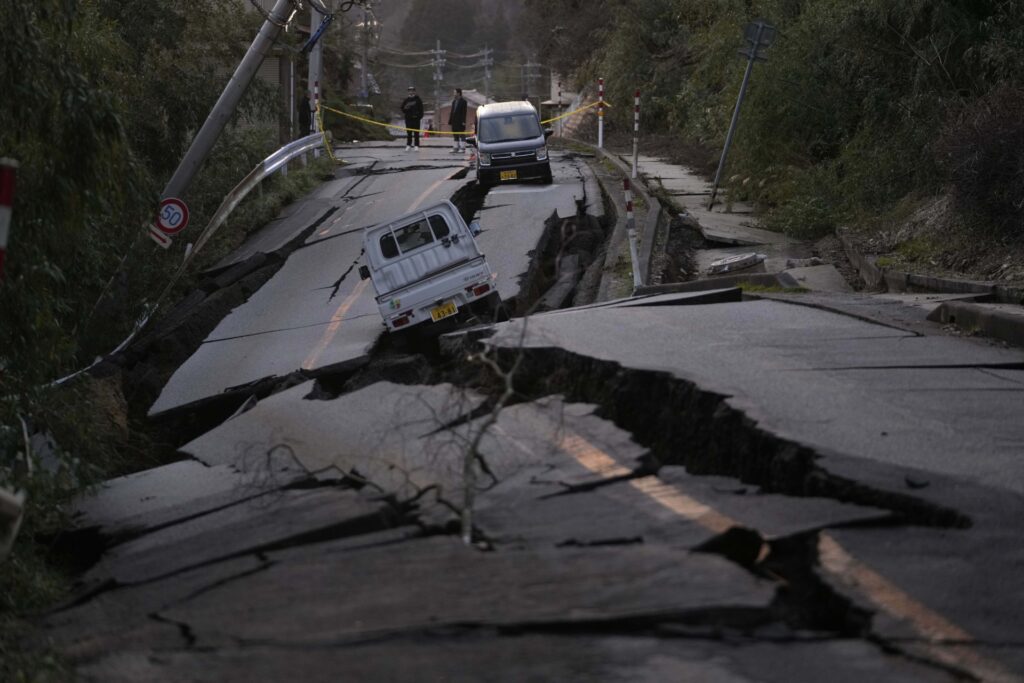Japanese authorities tallied 94 deaths, 222 people missing, and 846 trapped in unreachable parts of the Noto Peninsula on Friday as a result of the devastating 7.6-magnitude earthquake that occurred on Japan’s west coast on Monday.
The death toll is expected to grow, as rescuers believe many of the missing are trapped under the rubble of communities destroyed by the earthquake, burned in the subsequent fires, covered in mudslides, or swept away by the ensuing tsunami. The lives of many survivors who escaped their homes but are staying in shelters inaccessible to emergency services are still threatened, as the earthquake cracked some of the major roads deeper into the Noto Peninsula into pieces, rendering them useless.
Also complicating rescue efforts is the advanced age of many living in the region. Slightly over half the population of Suzu, one of the cities most severely damaged by the earthquake, was over the age of 65 as of 2020, Japanese media noted. The mayor of Suzu, Masuhiro Izumiya, told reporters on Tuesday that he believed 90 percent of the homes in his city were “completely or nearly completely destroyed.”
The Yomiuri Shimbun, a national Japanese newspaper, reported Friday that some survivors had been forced to trek up the precarious paths created by landslides into parts of the region still connected to the rest of Japan to find food and water. Both food and water supplies jeopardize the safety of hundreds believed to be in otherwise secure locations on the other side of the broken roads.
“Residents have not received relief supplies from the central or local governments since the earthquake occurred, and some have walked across landslide debris to receive and distribute items at evacuation centers,” Yomiuri reported. “A 79-year-old woman huddled in an evacuation center said, ‘Our food stockpiles and other items will eventually run out. I’m worried without prospect for [the] opening of roads.’”

Bystanders look at damage near Noto town in the Noto peninsula facing the Sea of Japan, northwest of Tokyo, on January 2, 2024, following Monday’s deadly earthquake. (AP Photo/Hiro Komae)
The newspaper described scenes of locals in the region “climbing over piles of dirt several meters high while holding cardboard boxes filled with plastic bottles.” Some in Wajima who spoke to Yomiuri noted that they could not carry too many supplies, as the heavier the weight of the people passing, the more potential for the soft ground to move and potentially trigger another mudslide down to where survivors are located.
“A massive landslide triggered by the quake completely blocked the road, forcing people to make their way by climbing up and down the mountain of dirt,” the newspaper described in one neighborhood of Wajima.
Some residents of Wajima have reportedly chosen not to go to evacuation centers despite having lost their homes, as they are crowded and poorly supplied, so they are sleeping in their cars and garages, Yomiuri reported.
Japanese media estimated that up to 68,000 homes in 14 cities had lost their water supply since Monday. Given the urgency of ensuring survivors have access to drinking water, Japan’s Transport Ministry is reportedly preparing to overcome the challenges posed by broken roads by sending ships full of water and other basic goods, such as diapers, around the coast to those in evacuation shelters. Reports indicated the first such shipment would arrive on Friday night local time.
Japanese media outlets noted that experts believe the possibility of finding survivors under the rubble falls dramatically after the 72-hour mark, though some miraculous rescues have occurred, including that of an octogenarian woman pulled out of her home alive on Thursday in the devastated city of Wajima.
According to Japan’s Asahi Shimbun newspaper, doctors described the woman as being in “stable condition” despite her advanced age and being trapped in her home for more than 72 hours. The Kyodo News agency published a video showing rescue crews from Osaka pulling the woman out of the house.
While tsunami alerts have subsided, the region faces some minor aftershocks and the potential for more as of Friday. Local reports documented first responders having to halt their work as aftershocks occurred, standing in the middle of broken streets as far from tall debris and the skeletons of damaged buildings as possible.
The Noto Peninsula does not have a history of high-magnitude earthquakes or historic tsunamis, though all of Japan experiences some level of seismic activity, given its proximity to fault lines. Asahi noted that many locals hesitated to evacuate following tsunami warnings.
“We thought [the] tsunami was someone else’s problem, and the entire community lacked a sense of crisis,” Seiji Fuwa, a local in Noto, told the newspaper, describing his sometimes unsuccessful attempts to convince elderly locals to evacuate to higher ground.
“Although the Noto Peninsula has experienced frequent earthquakes over the past few years, people had grown accustomed to the fact that [a] tsunami had not come,” Asahi reported. Many of the elderly residents live alone, the newspaper noted, which may delay the discovery that many are missing, as they do not have local family to account for them.

COMMENTS
Please let us know if you're having issues with commenting.